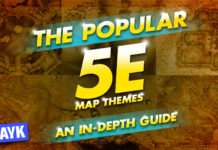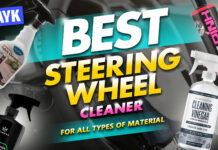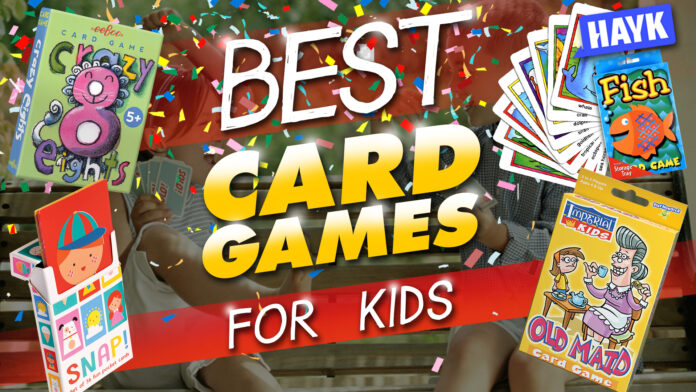
Playing card games with the kids is a fun and inexpensive way to spend some quality time with the family. Moreover, it also helps promote a child’s strategic thinking, mathematical, and memory skills.
But popular games like poker won’t be as fun for kids as it is for adults. That’s why we spent hundreds of hours to present you the top 20 fun card games for kids.
P.S: The games on the list can be played by children as young as 3 years old. We also included a downloadable PDF file containing images and instructions on how to play each card game.
Contents of this Page
Why Should Your Kids Play Fun Card Games?
Playing card games with children is a great way to help develop their cognitive, emotional, and motor skills. The simple act of holding the cards in their tiny hands is already beneficial for both their hand-eye coordination and dexterity.
But keeping the children entertained throughout the game session is a bit challenging for most parents. That is why we specifically compiled only the most entertaining card games for kids. Read on to see the list.
How are the Games Rated?
Each game is rated according to how child-friendly they are, how easy they are to execute, and how fun they are when played with the family.
Some card games are slightly complicated than the others and are tailored to older children while some are easy and can be played by children as young as 3 years old. Because of this, having a lower rating doesn’t mean they are not worth playing with the kids.
Each game is fun in its own way and we highly recommend you to try them so long as your child is old enough to play the game.
What are Fun and Easy Card Games for Children?
1. Snap
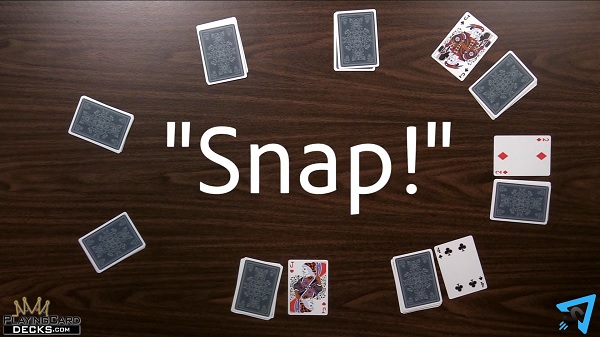
Age: 3+
Game Type: Competitive
Mechanism: Pattern recognition
Objective / Goal: Collect the entire pack of cards to win
Number of Players: 2 to 12 players (best played by 2-6 players)
Duration: Up to 10 minutes
Cards: Standard 52-deck card, any custom Snap cards
Alternate names: Alphabet Snap, Andy Pandy Snap, Animal Grab, Animal Snap, Around Europe Snap, Bandsman Snap
Rating: 3.5 / 5
Download the PDF game instructions here: Snap Card Game (PDF)
How to Play:
The game starts when the dealer shuffles the cards and deals them as evenly as possible to all of the participating players. Don’t worry if the cards don’t get distributed evenly– some players will have one card less than other players.
Each player will then have their cards in a pile face down in front after the dealer shuffles every card.
The first player who will make the move will be the player to the left of the dealer then moves clockwise. Each player turns over the top card from the face-down pile of cards.
When a player turns over a card that matches another card already face-up on another player’s pile, the players then race to call out the word “Snap!”. The player who calls the word first wins both piles and adds them to the bottom of the face-down pile of cards.
If a player calls the word “Snap!” at the wrong time, they must give their top card to the player who just flipped their card. If the player who just played makes the mistake during his turn, he must surrender his top card to the player to his right.
This goes on until one player wins all of the cards.
2. Memory
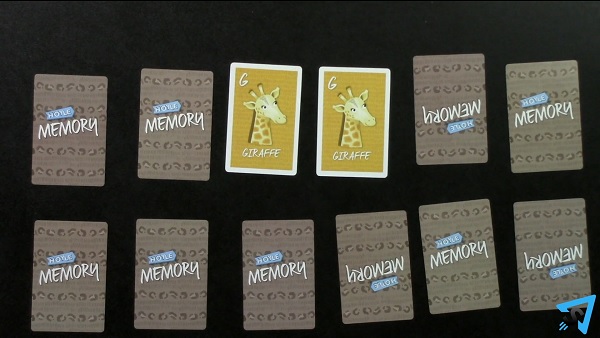
Age: 3+
Game Type: Competitive, team-based
Mechanism: Memory, set collection
Objective / Goal: Collect the most number of pairs
Number of Players: 1 to 6 players (best played by 2 players)
Duration: Up to 30 minutes
Cards: Standard 52-deck card, custom Pairs deck
Alternate names: Concentration, Matching Pairs, Match Match, Match Up, Memory, Pleonasm, Shank, Pexeso, or simply Pairs
Rating: 4.3 / 5
Download the PDF game instructions here: Memory Card Game (PDF)
How to Play:
The goal of the game is to collect the most pairs of cards. It starts with all the 52 cards laid face down on the table. Ideally, you will want to lay them face down in a pattern (e.g, 4 cards x 13 cards)
The youngest player goes first and proceeds clockwise. The youngest player goes and flips 2 cards (one at a time). If the cards have matching numbers or faces, the player gets to keep both cards. If the cards don’t match, both cards are then turned face-down again.
When all the pairs have been found, the player with the most number of pairs wins.
3. Old Maid
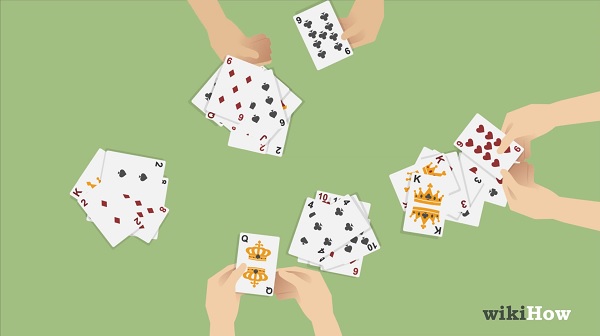
Age: 4+
Game Type: Shedding game
Mechanism: Hand management, bluffing, hot potato, set collection
Objective / Goal: Don’t be left with the “Old Maid” at the end of the game session
Number of Players: 2 to 8 players (best played by 4 players)
Duration: As fast as 5 minutes
Cards: Standard 52-deck card or a tailor-made junior version deck of cards
Alternate names: Chase the Ace, Old Boy, Black Peter, Black Susy, Cat Lady Old Maid
Rating: 3.8 / 5
Download the PDF game instructions here: Old Maid Card Game (PDF)
How to Play:
Before the game starts, throw away all but one Queen card from the deck. The remaining Queen card will be the “Old Maid”.
The game starts by evenly distributing the cards face-down to all participating players. It’s totally fine for other players to have one card more or less than the rest.
The players then take their face-down pile of cards and discard any pairs they may have. If the player has three of a kind, they must only discard two and keep the third.
You dealer of the cards gets to go first and offers his hand, face-down, to the player on his or her left. The player on the left then randomly takes one card from the dealer. If the card has a pair, then he puts the pair down. If it doesn’t have a pair, then the player gets to keep the card.
The play proceeds clockwise and repeats the cycle until there are no more pairs and the only remaining card is the Old Maid. The player holding the Old Maid loses.
4. Crazy Eight
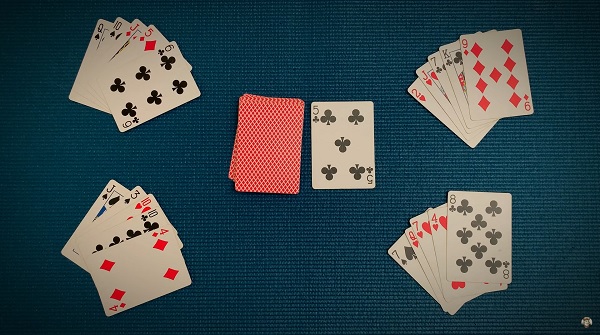
Age: 5+
Game Type: Shedding
Mechanism: Hand Management, Matching
Objective / Goal: Be the first player to use up all your cards
Number of Players: 2 to 5 players
Duration: Up to 20 minutes
Cards: Standard 52-deck card
Alternate names: 101, Crazy 8’s, Alpha, Eights, 8 Loco
Rating: 4.4 / 5
Download the PDF game instructions here: Crazy Eight Card Game (PDF) (to be updated)
How to Play:
The dealer starts the game by dealing seven cards (in a two-player game) or five cards (in a three or four-player game).
The rest of the deck then goes face-down in a pile with the top card turned up and placed beside it. The face-up cards are called the discard pile.
The first player to play the game will be the player either to the left or right of the dealer and match either the suit or the number of the top card in the discard pile.
Let’s say the top card of the discard pile is a five of hearts. The player who goes first can throw any card on their hand that is either five or hearts. If the player doesn’t have a matching card to play, he or she then has to get one card from the face-down deck until he gets one he can discard.
The wild card in the deck is the Eight card– this can be put down on any suit or number. For example, the player doesn’t have any five or hearts but has an Eight card, the player can use this card to cover either the number or the suit.
The next player then continues and is meant to play the number or suit the Eight was meant to cover.
The cycle repeats until a player uses up all of his cards. Should the face-down deck run out before the game is over, the discard pile will be shuffled before putting it back face-down.
5. Go Fish
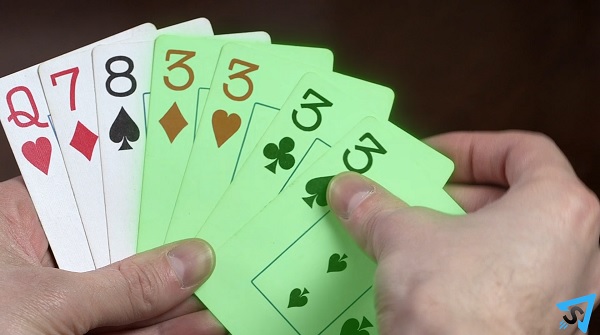
Age: 7+
Game Type: Matching, Pairing
Mechanism: Memory, Set collection
Objective / Goal: The first player who discards all his cards wins
Number of Players: 2 to 6 players
Duration: Up to 20 minutes
Cards: Standard 52-deck card
Alternate names: Fish, Alphabet Go Fish!, Freshwater Go Fly Fish, Finding Nemo Go Fish
Rating: 3.7 / 5
Download the PDF game instructions here: Go Fish Card Game (PDF) (to be updated)
How to Play:
The dealer starts handing out cards to the players and deals each player seven cards (if there are three players) or five cards (if there are 4 or more participating players). The rest of the cards are then placed face-down in a pile. This is called the “fish pond”.
The goal is to collect as many sets of four cards and start with the player to the left of the dealer. This player will be the “requester”. The requester can ask for a specific card from any player or “giver”. If the giver has the card the requester asks for, the giver has to give all of her cards of that rank to the requester.
For example, if the requester has three Queens, he or she will ask the giver for Queens. If the giver has the cards, he or she will hand them over and the requester can continue asking for more specific cards from the same player.
This goes on until the giver can’t hand over the requested cards and tells the requester to “Go Fish”. The requester then has to take a card from the pile of face-down cards or “fish pond”.
If the requester happens to draw a card of the rank asked for, the requester has to show it to the rest of the players and you get another turn of request from any player. However, if you draw a card that is not the rank you asked for, you keep the drawn card and the one who said “Go Fish” will play next as the requester.
The winner of the game will be the first player who discards all his cards. If two people get to discard all their cards at the same time, the player with the most sets of four cards wins the game.
6. War

Age: 4+
Game Type: Catching type
Mechanism: Counting, card values
Objective / Goal: Win all the cards to win
Number of Players: 2
Duration: Up to 40 minutes
Cards: Standard 52-card deck
Alternate names: Battle, Tug of War, Egyptian War Card Game, Scumbags and Warlords, War Card Game
Rating: 3.3 / 5
Download the PDF game instructions here: War Card Game (PDF) (to be updated)
How to Play:
The game starts by distributing the 52-card deck evenly to the 2 players. Each face and number of the card is ranked accordingly with Ace being the highest and 2 being the lowest card in rank.
Both piles of the deck are left face down and both top cards of both piles are put face up. The player with the higher value card wins the card of the opponent and puts this at the bottom of his or her pile.
In case the cards have equal value, a “war” happens. What happens then is both players place 3 facedown cards on the table then place another face-up card on top of those three cards. The player with the higher value card then wins all the cards and is put at the bottom of their pile.
Now, if the second batch of face-up cards is still the same in rank, another set of face-down cards with a fourth face-up card is then cast until one player has a higher value card. This process goes on until one player wins all the cards.
The player also loses when they do not have enough cards to finish a war.
7. Slap Jack
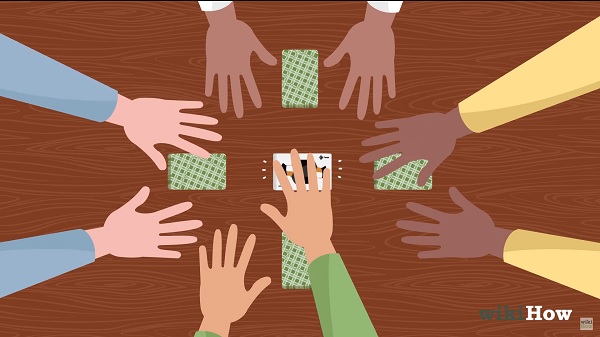
Age: 5+
Game Type: Matching type
Mechanism: Visual alertness, fast response
Objective / Goal: To win all the cards by being the first to slap each “jack” as they are played
Number of Players: 2 to 8 players (best played by 4 players)
Duration: Up to 30 minutes
Cards: Standard 52-card deck
Alternate names: Slapjack, Spank the Berry Bird, Slap(s)
Rating: 3.4 / 5
Download the PDF game instructions here: Slapjack Card Game (PDF) (to be updated)
How to Play:
The game starts with the dealer dealing all the cards out evenly to all the players. Players are not allowed to look at their cards but instead squares the cards up his hand into a neat pile (face-down) in front of them.
The order proceeds clockwise and starts with the player to the left of the dealer. The first player will start the game by discarding his top card face-up and placing it in the center of the table or the play area. Note that this has to be done in a swift manner so as to ensure everyone gets to see the card at the same time.
If the “Jack” card shows up, all the participating players will race to slap the card, hence, the name, “Slap Jack”. The first player to slap Jack collects all the cards in the center and places them at the bottom of his or her piled cards.
The play then continues to the left of the player who slapped first. If a player slaps a card that is not a “Jack”, the player then has to give his or her top card to the player they wrongly slapped. The player then adds the discarded card at the bottom of their pile of cards.
If a player runs out of cards to discard, they will be skipped but is still able to “slap Jack” and get back or even win the game. However, if they slap another card that still isn’t Jack, they will be out of the game permanently.
This process goes on until one player gets to win all 52 cards.
8. Spoons
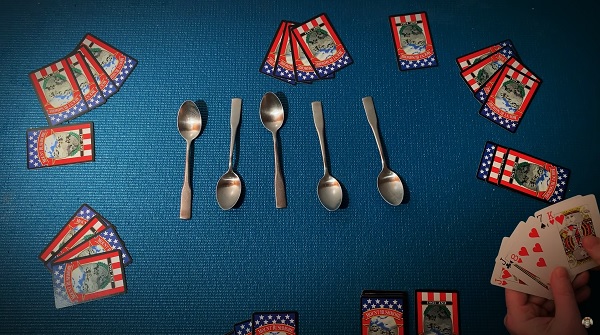
Age: 6+
Game Type: Collecting type
Mechanism: Player elimination, Set collection, simultaneous action selection
Objective / Goal: Be the last player standing
Number of Players: Up to 13 players (best played by 4-10 players)
Duration: Up to 30 minutes
Cards: Standard 52-card deck
Alternate names: Donkey, Pig, Cork, Giant Spoons, Grab-a-nana, Gone Bananas, Sink or Swim, Splash, Tiny Tins Spoons
Rating: 4.6 / 5
Download the PDF game instructions here: Spoons Card Game (PDF) (to be updated)
How to Play:
Apart from the 52-card deck, you will also need spoons, but you will only use 1 spoon fewer than there are players (i.e, you will only need 5 spoons when playing Spoons with 6 players).
The dealer starts by dealing 4 cards face-down to each player. Each player then checks their cards and try their best to make a 4-of-a-kind.
The game starts when the dealer takes a card from the top of the remaining pile of cards and discards any card they wish to their left in a face-down position. The player to the left then takes the discarded card and discards another card they wish to the next player. The process continues until one player gets to complete a 4-of-a-kind.
When a player gets a 4-of-a-kind, they can take a spoon from the center of the play area. Note that they can do so quietly or as loudly as they can. Once the first spoon has been taken, the rest of the players will then race to take a spoon as well, regardless if they have a 4-of-a-kind or not.
The remaining player without a spoon will be given 1 letter at the of the round. The letters given to players are spelled “S-P-O-O-N-S”. When a player gets to complete the words “Spoons”, they will be eliminated and there will be 1 spoon fewer for the remaining players. This process goes on until there will only be 1 player left.
If ever nobody has made a 4-of-a-kind and the deck runs out, the discard pile of the last player will be shuffled and will be used instead to continue the game.
If a player mistakenly takes a spoon from the center of the play area without getting a 4-of-a-kind, that player will be given a letter.
The duration of the game can be changed depending on the words that need to be spelled out. If you want the game to be shorter, you can use “dog” or “cat” as the words that need to be spelled out.
9. Snip Snap Snorem
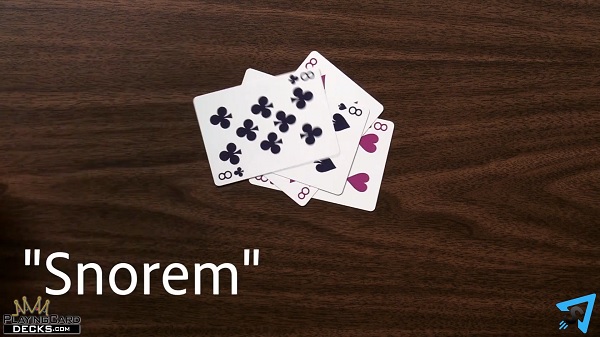
Age: 4+
Game Type: Matching, Shedding
Mechanism: Set pairing
Objective / Goal: Be the first player to get rid of all your cards
Number of Players: 4 to 8 players
Duration: 5 minutes
Cards: Standard 52-card deck
Alternate names: Snip snap snorum, Snip snap snorre, At the zoo
Rating: 4.2 / 5
Download the PDF game instructions here: Snip Snap Sorem Card Game (PDF) (to be updated)
How to Play:
Shuffle the standard 52-card deck and deal all the cards to the players. The player to the left of the dealer will play first and rotate clockwise. He or she can put down any card they wish to the center of the play area or the table.
The next player then has to match the card that was just played.
For example, player 1 played 6 of hears, then the next player should play any 6 cards they have and say “snip”. The next player then has to play another 6 cards on their hand and say “snap”. The last player who will throw the last 6 cards will play “snorem” and can start the new round by playing any card they wish to.
The process goes on until a player gets rid of all his cards and will be crowned the winner.
10. Beggar My Neighbour
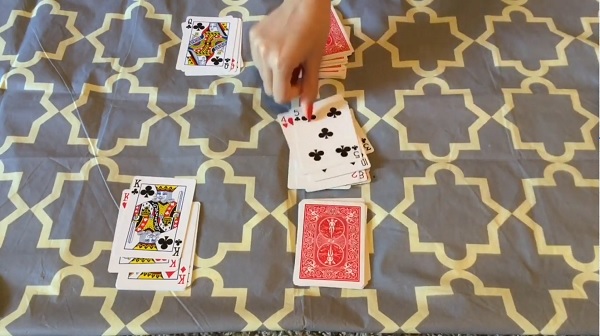
Age: 6+
Game Type: Adding-up-type
Mechanism: Counting
Objective / Goal: Get your opponent to run out of cards
Number of Players: Up to 2
Duration: Up to 15 minutes
Cards: Standard 52-card deck
Alternate names: Strip Jack naked, Draw the Well Dry, Beat your neighbour out of doors, Beat Jack out of doors
Rating: 3 / 5
Download the PDF game instructions here: Beggar My Neighbor Card Game (PDF) (to be updated)
How to Play:
A standard 52-card deck will be shuffled before being dealt equally to both players face-down.
Similar to the card game, War, the game solely relies on luck and is played depending on the value of the card that was just played. In the case of Beggar my Neighbor, only the face cards have value and are valued as follows:
- Ace = 4 chances
- King = 3 chances
- Queen = 2 chances
- Jack = 1 chance
The game starts with either one of the two players flipping their top cards to the middle of the table or the play area face-up. Both players take turns flipping their pile of cards over to the middle of the play area until one plays a “face card”.
When the player gets to play any face card, the opposing player will have a chance(s) to “counter” the played card with another face card. If the opposing player uses up all his chance(s) and is not able to counter with another face card, the entire pile of “played cards” will be put at the bottom of the player that first played a face card.
If the player gets a face card during or before he runs out of chance(s), the player then returns the favour and gives the opposing player a chance(s) to counter the played card.
The process continues until one player runs out of cards to play. The player who has all the cards wins.
11. Rummy
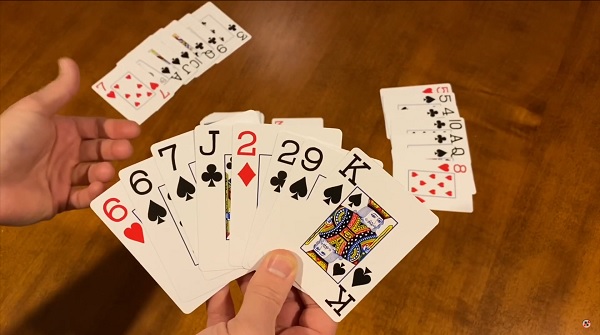
Age: 8+
Game Type: Matching type
Mechanism: Melding and splaying, set collection
Objective / Goal: Win by getting rid of all the cards in your hands or by having the most points at the end
Number of Players: 2 to 6 (best played with 4 players)
Duration: Up to 30 or more minutes
Cards: Standard 52-card deck
Alternate names: Rummy 500, 500 Rum, 500 Rummy, Animal Party, Circus Rummy, Dinosaur Fours, Classic Rummy, Fireman’s Rummy, Tree Game, Zoo Rummy
Rating: 4.5 / 5
Download the PDF game instructions here: Rummy Card Game (PDF) (to be updated)
How to Play:
There are many different versions of Rummy but Rummy 500 is the most commonly played form of Rummy. Using a standard deck of 52 cards, the dealer starts the game by shuffling the deck before distributing it equally to the players.
If there are 2 players involved, each player will be dealt with 10 cards. If there are 3 to 4 players, each player will be dealt with 7 cards. Only 6 cards per player will be dealt if there are 5 to 6 players involved.
The goal is to either get rid of all the cards in your hand or win by having the most points at the end of the game (in cases where no one gets to rid of all cards by the end of the round).
After the cards are dealt, one card is left face-up in the middle of the table or play area. The player to the left of the dealer can then either take the face-up card or take one face-down card from the pile– it’s their choice.
A player can take a card from the bottom pile of the discarded face-up pile but they must also take all the cards on top of it and discard the lowest valued card as soon as they pick it up. At the end of every turn, each player has to discard one card. Should the face-down pile runs out, the discard pile will be taken, shuffled and re-used as the face-down pile of cards and leaves the latest discarded card as the face-up card.
The player has the option to meld or lay off cards on the table during their turn or not and hold their cards for as long as they want to. Melded cards are either sets (groups of cards with the same value from different suits) or run (three or more consecutive cards of the same suit). The rest of the players can also meld to all the melded or laid off groups on the table during their turn.
As soon as a player discards all of his or her remaining cards, all players stop and the player who wins receive points for the remaining cards in another player’s hands. Number cards from 2-10 are worth their corresponding values while face cards like Jack, Queen, and King are worth 10 points. Ace cards have the lowest point as they are worth only 1 point.
A player goes Rummy when they get rid of all their cards in one turn without having previously melded or laid off any cards. In this case, the winning player gets twice as many points. The score for that game is then tallied and another game starts.
This goes on until a player reaches a predetermined point total. Depending on the predetermined point total will be how long the game will last.
12. Cheat
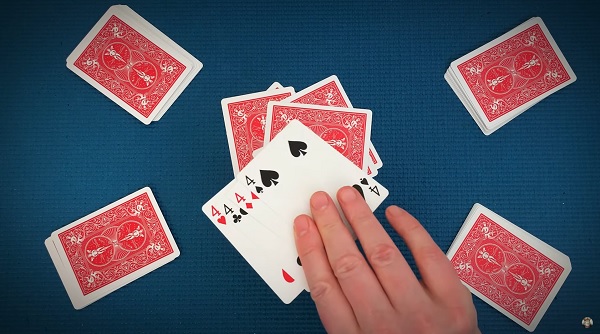
Age: 8+
Game Type: Shedding type
Mechanism: Memory, counting, sequencing
Objective / Goal: Win by discarding all of the cards on your hand
Number of Players: 4 players per 52-card deck
Duration: Up to 10 minutes
Cards: Standard 52-card deck
Alternate names: Bluff, Bullsh*t, Dubito, I Doubt It, Liar
Rating: 4.5 / 5
Download the PDF game instructions here: Cheat Card Game (PDF) (to be updated)
How to Play:
An entire standard deck of 52 playing cards will be distributed to all participating players. This is a game of deception, memory, counting, and sequencing.
The player to the left of the dealer will play first and continue in a clockwise pattern. The first player will start the game by discarding 1 to 4 cards of Ace cards onto the stack of discarded cards. For example, they can start by telling everyone they are discarding 1, 2, 3, or 4 cards of Aces onto the pile of discarded cards. Because the cards are put face-down, everyone can’t really tell whether the player is telling the truth or not.
The next player then tells everyone they are discarding anywhere between 1 to 4 2’s onto the discard pile. Again, they can either be truthful or “bluffing”. This goes on until you reach the King before you go back to Ace.
Anybody during the game can accuse or challenge someone for bluffing. If the player accused is guilty of bluffing, the accused then takes all the cards from the discard pile and adds them onto their hands. However, if a player wrongly accuses a player, they instead take all the cards from the discard pile and add them onto their hands.
The game continues where they left off and the process goes on until a player discards all the cards on their hands. The first player to empty their hands wins.
13. 31

Age: 10+
Game Type: Point-trick type
Mechanism: Set collection
Objective / Goal: Get the value of the cards in your hands closer to 31 than at least 1 player
Number of Players: 4
Duration: 10 to 30 minutes
Cards: Standard 52-card deck
Alternate names: Big Tonka, Nickel Nock, Blitz, Clinker, Klinker, Scat, Cadillac
Rating: 4.4 / 5
Download the PDF game instructions here: 31 Card Game (PDF) (to be updated)
How to Play:
Pick a dealer and have him or her shuffle the standard 52-card deck. Deal 3 cards to each player with the cards face-down and have one card face-up to start the discard pile.
Each player is given 3 lives which will be deducted by either 1 or 2 if they lose the game. More on this later.
The goal of the game is to get the value of the cards in your hand to be closer to 31 than at least 1 player. The player furthest from 31 after the game loses a life.
Each card represents a value and is valued as follows:
- Ace = 11
- Jack, Queen, King = 10
- 2 to 10 = face value
At the end of the game, only the cards of the same suit are added together. For example, player 1 has two hearts cards and one club. Only the value of the two hearts cards will be added together.
The value of the player’s cards will always be 30 if all three cards are of the same suit, regardless of the card rank. In case all three cards are of different suits, then the card with the highest value will be the player’s final value at the end of the game.
The game starts with the player to the left of the dealer and takes either 1 card from the face-down pile cards or the top card from the discard pile. Once a card is drawn, the next player (clockwise order) has to pick a card to discard and put it on top of the discard pile.
When a player is confident enough of the cards in hand, he can “knock”. After a knock, the other players get one more turn to draw a card. Everyone’s cards are shown after the last player has drawn. The player with the lowest card value loses a life.
However, if a player has a card value of 31, the game ends and every other player loses 1 life. Should the player that calls a “knock” ends up having the lowest card value, he or she instead loses 2 lives.
If the player that knocks and another player tie for the lowest value, the person that did not knock automatically loses 1 life. However, if two players that did not knock tie for the lowest value, both the players lose 1 life.
The player that loses their 3rd life is still in the game and only then will they be out if they lose with no life left. The winner of the game will be the last player still alive.
14. Kemps
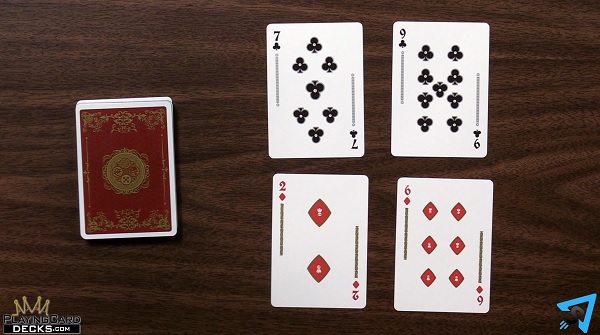
Age: 4+
Game Type: Communication type, cooperative
Mechanism: Hand management, set collection
Objective / Goal: Be the first team to come up with a 4-of-a-kind card
Number of Players: Up to 8 players divided into teams of 2
Duration: Up to 30 minutes
Cards: Standard 52-card deck
Alternate names: Peanut butter
Rating: 4.5 / 5
Download the PDF game instructions here: Kemps (PDF) (to be updated)
How to Play:
Divide the players into teams of two and have them come up with a secret non-verbal gesture to signal their teammate they have a 4-of-a-kind or to signal that their opponent has got it first. This non-verbal gesture could be anything from a wink, tap in the ear, or finger on their nose.
The dealer starts by shuffling a 52-card deck of standard playing cards before dealing 4 cards to each team. Players are then allowed to look at their cards to check which cards to discard later and which cards to keep.
Once everyone is ready, the dealer then flips over the top 4 cards of the stock into a 2×2 face-up grid on the table. Note that there are no turns here and everything happens simultaneously. However, players may only swap their cards one at a time from the middle face-up grid to come up with a 4-of-a-kind.
When everyone is done swapping, the dealer then discards the 4 face-up cards on the table and flips over another set of 4 cards. The process happens again until a team comes up with a 4-of-a-kind.
When a player comes up with a 4-of-a-kind, the team then signals their partner to call out the words “Kemps” and gains 1 point. If the partner calls out “Kemps” but don’t really have 4-of-a-kind, the team loses 1 point instead.
A team also earns a point if they call out the words “Cut” or “Counter-Kemps” if they think the opposing team has come up with a 4-of-a-kind first. However, they have to say the words first before the team calls out the words “Kemps”.
If the accused indeed has a 4-of-a-kind, then the team that called out “cut” wins a point and the round ends. The team that calls out the words “cut” will lose a point if the accused team doesn’t have a 4-of-a-kind.
The game starts over when a point is given and the role of dealer rotates clockwise by one. The process repeats until a team reaches a predetermined score (i.e, first to score 5 wins).
15. 52-Card Pickup
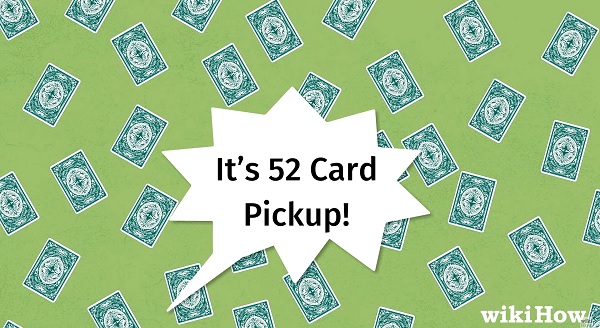
Age: 3+
Game Type: Picking up objects
Mechanism: Hand-eye coordination
Objective / Goal: Pick up all the cards
Number of Players: 2 or more
Duration: Up to 5 minutes
Cards: Standard 52-card deck
Alternate names: Pickup 52
Rating: 3 / 5
Download the PDF game instructions here: 52-Card Pickup Card Game (PDF) (to be updated)
How to Play:
The game is typically played as a practical joke, where the “dealer” creates a false impression that they will play a legitimate card game.
The game starts with the dealer asking a toddler (or a child who doesn’t know about the game yet) if they want to play the 52-card pickup game.
If they say no, the game ends abruptly and nothing follows. But if they say yes, then say “Here are 52 cards”, and pinch the deck between your thumb and fingers to scatter the cards around the player.
After which, the dealer will then say, “now, pick them up”.
The game has been used for legitimate educational children’s games to promote a toddler’s hand-eye coordination.
16. House of Cards
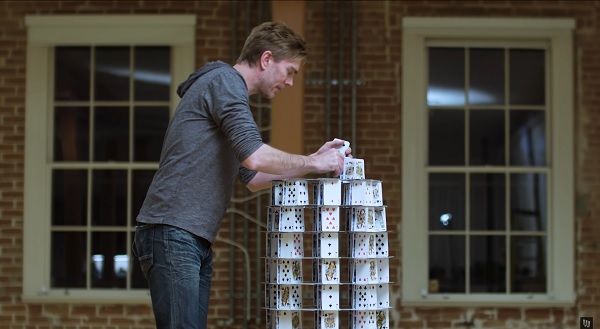
Age: 8+
Game Type: Creative
Mechanism: Hand-eye coordination
Objective / Goal: Build a structure using a standard 52-card deck
Number of Players: 2 or more
Duration: Anywhere from 10 minutes to 90 minutes (or even over)
Cards: Standard 52-card deck (preferably 2 packs)
Alternate names: Card tower, Card castle
Rating: 4 / 5
Download the PDF game instructions here: House of Cards (PDF) (to be updated)
How to Play:
Before anything else, find a flat surface area where nobody else can disturb the players. It is highly recommended to use a room for this activity to limit the possible disturbance throughout the game session.
Note that the game session can be anywhere from 10 minutes to even over 90 minutes in some cases, depending on the extremity of the desired output. You can use 1 deck of the standard 52-card deck and be done in more or less 10 minutes or use more than 3 decks of cards and enjoy the adrenaline for about 45 minutes– it’s really up to you.
The general idea of the game is to build a house of cards by using all the cards in the pack. The game doesn’t allow you to bend, staple, mutilate or roll the cards in any way.
Among the most popular starter builds in a house of cards is to build a structure of four cards in a box shape and a roof. You can go as simple as that or you can go as complex as building an entire castle.
Being careful throughout the building process is key in the game of house of cards. With utmost patience and care, you will soon have built a castle or even an entire village!
You can spice things up by including other toys such as Legos, Monopoly cards, and even sports cards if you need more cards for building.
17. Happy Families
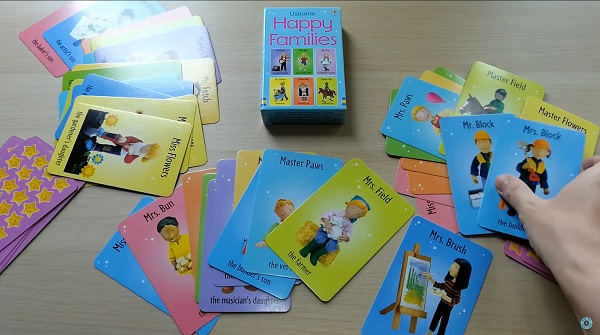
Age: 3+
Game Type: Matching type
Mechanism: Memory, set collection
Objective / Goal: Win by having the most completed family at the end of the game
Number of Players: 3 to 4
Duration: 10 to 30 minutes
Cards: Custom Happy Families deck (ideal), but can use Standard 52-card deck
Alternate names: Quartett, Ablegspiel, 7 Familles, Animal Families, Busy Families
Rating: 4.5 / 5
Download the PDF game instructions here: Happy Families (PDF) (to be updated)
How to Play:
The game is similar to Go Fish except this requires a specific Family type deck with custom-made jobs. The game is also similar to the old German Quartett cards where each group or family is composed of four cards.
Each family consists of four family members– a father, a mother, a son, and a daughter. The job ranges greatly nowadays but originally, the jobs you would find in a deck of Happy Families were:
- Painter
- Baker
- Doctor
- Grocer
- Carpenter
- Barber
- Dyer
- Sweep
- Tailor
- Brewer
The game starts with the dealer dealing all the cards to all participating players. Don’t worry if some players get 1 more or less than the rest. The dealer then starts the game by asking the player to his or her left if they have a specific member of the family.
If the asked player has a family member, the requester can proceed and ask for more. If the asked player doesn’t have a family member, then it’s the asked player’s turn to become the requester and ask for a specific family member to his left.
When a player has a complete family in his or her hand, they then put the family face-up on the table for all the players to see.
The cycle continues until all the families are brought together. The winner at the end of the game will be the player with the most families.
18. Play or Pay
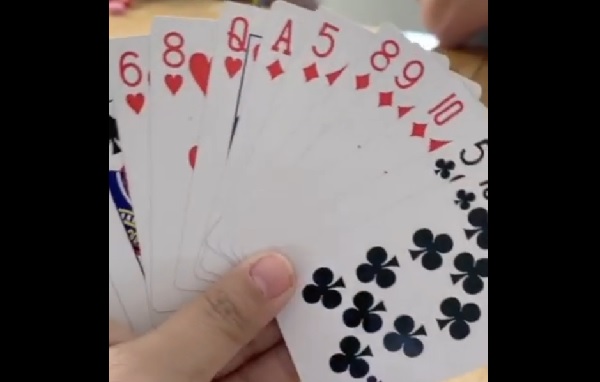
Age: 5+
Game Type: Shedding type
Mechanism: Set collection, speed matching
Objective / Goal: Be the first player to get rid of all their cards
Number of Players: 2 to 4 per 52-card deck
Duration: 10 minutes to 15 minutes
Cards: Standard 52-card deck
Alternate names:
Rating: 4.3 / 5
Download the PDF game instructions here: Play or Pay (PDF) (to be updated)
How to Play:
Before you can start playing Play or Pay, each player must have a handful of tokens that they can use to “pay” when they can’t play any cards.
The game follows a specific number order where King is the highest value and Ace being the lowest.
The game starts with the dealer dealing all the cards out to the players face down. Note that some players might get fewer cards than others. Once all the cards are dealt, the player to the left of the dealer starts the game by placing any card of his or her choice on the table facing up.
Each player takes turns in a clockwise pattern and should put either a higher number of the same suit connecting the card of the previous player or another card of a different suit.
For example, if the first player played a six of hearts, then the second player should play a 7 of hearts or a card of a different suit, like a 9 of spades for instance.
The third player can connect to either of the two suits on the table or can play another card of a different suit. Eventually, all suits will be played on the table and all the players will have to connect to either of the 4 suits.
Note that you can only connect to any of the suits once. Now, if a player can’t connect to any of the suits, the player has to “pay up” using the “token” they have. To make it child-friendly, you can just use candies or chocolates as tokens.
The cycle continues until a player gets rid of all their cards. The winning player also gets to win all the tokens that have been accumulated throughout the game session. On a similar note, the player who uses up all his tokens will automatically be out of the game. You can plan ahead to use an unlimited or limited number of tokens for a smooth game transition.
19. Chase the Ace
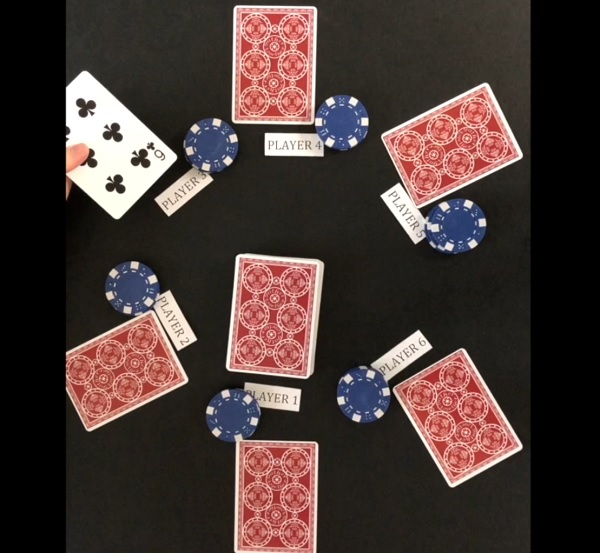
Age: 6+
Game Type: Shedding game type
Mechanism: Player elimination
Objective / Goal: To not have the lowest card value at the end of each round
Number of Players: Anywhere from 2 to 9 (5 being the most ideal)
Duration: 10 minutes to 30 minutes
Cards: Standard 52-card deck
Alternate names: Ranter-Go-Round, Cuckoo, Bohemian Poker, Screw Your Neighbor, Stick or Swap, Bring the King, or Chicago Shuffle
Rating: 4.2 / 5
Download the PDF game instructions here: Chase the Ace (PDF) (to be updated)
How to Play:
Each player is given a limited number of “life” or token when they lose the round. Most of the time, players are given anywhere from 2 to 4 tokens as their “life”.
Before playing, each player must understand the rankings of the cards. Depending on the decision of the dealer, the ranking can be arranged into A K Q J 10 9 8 7 6 5 4 3 2 or K Q J 10 9 8 7 6 5 4 3 2 A. It has to be noted that the suit is irrelevant in Chase the Ace.
The game begins with the dealer dealing 1 face-down card to each player. Starting to the left of the dealer, he or she examines the card and decides to keep it or pass it.
If the player is satisfied with their card, they can just say “I’m keeping it” or something similar. In case the player isn’t satisfied with the value of their card, they can pass it to the player on their left while saying “I’m passing it” or similar, taking the player’s cards in return.
Note that the player to the left has no choice but to oblige to the exchange for the unwanted card and can only negate the request for trade if they are currently holding a “King” card of any suit, at which time they can show it to everyone to negate the effect.
The player holding a King is considered a complete turn and the game goes on and continues to the player to the left of the player holding a King. The cycle continues until the turn reaches back to the dealer. If the dealer is not satisfied with his or her card, they can exchange with the top card of the remaining deck instead of the player to their left.
If the top card of the deck is a King, the dealer will have no choice but to play their original card. After the last exchange, each player shows their cards and the player with the lowest card value loses a “life”. If two players tie at the end of the round, both of them lose a “life”.
Play continues as such until only one player with lives remains and takes all the “life” or token played by everybody else. The game then restarts when a player is announced the winner.
20. Mao

Age: 8+
Game Type: Shedding type
Mechanism: Pattern recognition, Simultaneous action selection
Objective / Goal: Get rid of all the cards in your hands as quickly as possible
Number of Players: 2
Duration: Up to 15 minutes
Cards: Standard 52-card deck
Alternate names: Slam, Speed
Rating: 3 / 5
Download the PDF game instructions here: Mao (PDF) (to be updated)
How to Play:
The game doesn’t take turns, so a player’s speed is an essential skill that will help them win this game. But unlike other fun card games for kids, both players are only allowed to use one hand throughout each game round.
The dealer starts dealing the entire deck to the two players after shuffling the standard 52-deck card. Both players are then required to make five stacks of cards in front of them in a row, as such:
- Stack 1: (0 cards face down), 1 card face up
- Stack 2: 1 card face down, 1 card face up
- Stack 3: 2 cards face down, 1 card face up
- Stack 4: 3 cards face down, 1 card face up
- Stack 5: 4 cards face down, 1 card face up
The remaining cards or the “spit” cards are placed on the table face-down. When both players are done setting up their stack of cards, they then say the words “Spit” and the game starts.
Simultaneously, both players flip the top card from their remaining stack of cards to the center of the table between them forming two separate “spit” piles before they race to discard all their cards to both “spit” piles in the middle.
Remember that the goal is to eliminate all the cards from all of your five stacks including your remaining card pile. But the cards you put on top of both “spit” piles must be either one rank lower or one rank higher than the current card on the “spit” pile. Suit and do not matter.
For example, the “spit” pile’s first card is 6 of hearts. This means you can place either a 5 or 7 of any suit. Also, note that Ace is higher than King and lower than 2.
When a face-up card is moved to the “spit” pile, immediately flip the face-down card face-up. Also, when one of your piles is empty, you are allowed to move any of your top cards from the four remaining piles to the empty pile.
Once a card is moved to the “spit” pile, you can no longer undo your move and you must continue playing if possible. If both players can no longer play or are stuck, then both players must say “Spit!”, and simultaneously flip one card from their “spit” card to the “spit” pile and continue the game.
The first player to play all the cards from their five stacks will then slap either “spit” pile with their hand and the round ends. The slapping player then takes all the cards from the slapped “spit” pile and adds them to their remaining “spit” cards, regardless of how few cards there might be. The other “spit” pile will then be added to the opponent’s “spit” cards.
Both cards from the two players are first shuffled before they deal out another round. In case one of the players has 15 cards or less, they will still make five stacks or as far as their cards will go. Moreover, the player with less than 15 cards will not have “spit” cards anymore so there will only be one “spit” pile left.
The cycle continues until one of the players “spit” all their cards to their opponent.
Looking for More Games? Check out Rise Magic’s Top 5 Best Card Games!
…or you can also check our print and play games for the family for card games similar to popular board games.
FAQ
What is a Kids Favorite Card Game?
There are plenty of card games to choose from but UNO Card Game has been a favorite for generations because it’s exciting, easy to learn, and fun for both children and adults.
What is an Easy Card Game to Play?
The game Snap is an easy card game for kids and requires only at least two players and a standard 52-deck card. The game is so easy to play that even 3-year-olds can participate.
What do Card Games Teach Kids?
Card games, while it seems simple and straightforward, actually teaches kids math and memory skills. Moreover, it also teaches kids strategic thinking according to sociologists and psychologists. The conversation and friendly rivalry that comes with sitting down to play cards is also a strong way to strengthen the bond of the family.
Is Pokemon Card Game Great for Children?
The packaging for Pokemon TCG products reflects the “6+” age range and puts a strong emphasis on good sportsmanship and respect for other players. Both the Pokemon card game and Pokemon video games encourage children to learn and read.
Because of the popularity of the Pokemon Card Game, people and collectors alike would go miles to keep the quality of the cards protected by investing in card sleeves and even custom-made Pokemon card sleeves.
Recap
Here is a list of fun card games for kids:
- Snap
- Memory
- Old Maid
- Crazy Eight
- Go Fish
- War
- Slap Jack
- Spoons
- Snip Snap Snorem
- Beggar My Neighbor
- Rummy
- Cheat
- 31
- Kemps
- 52-Card Pickup
- House of Cards
- Happy Families
- Play or Pay
- Chase the Ace
- Mao

